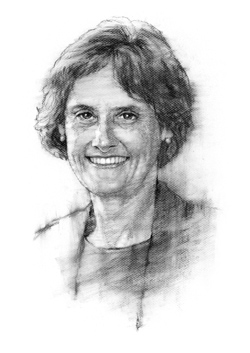|
||
      |
Talking points
NAME: Jeanne C. Marsh
 TITLES: Dean, George Herbert Jones professor, School of Social Service
Administration
TITLES: Dean, George Herbert Jones professor, School of Social Service
Administration
DEGREES: AB’69 (psychology), Michigan State University; MSW’72, PhD’75 (social work, psychology), University of Michigan
TERMS AS SSA DEAN: 1988–98; 2004–05 (acting dean); 2005–present
SUPPLY AND DEMAND: Over the last five or six years, applications have increased about ten percent each year. Right now we have 543 students—78 PhD students and 465 master’s students.
FIRST, KNOW THYSELF: Part of our curriculum focuses on thinking critically about a problem, how to know yourself as a person, and how to use your strengths to join with another individual to solve a problem or move forward. The idea of social work is doing with someone rather than doing to them. Given that educational context, we help students understand their sources of frustration and to think about how to maximize their sources of satisfaction. Biological research shows it does feel good to help people.
At SSA we have a lot of second-career people—investment bankers, lawyers, traders—who decide they want to do something more meaningful. They’re drawn to the positive, gratifying aspects of doing the work.
SOCIAL WORK’S GENDER GAP: Why are people altruistic? What’s satisfying about being a social worker? Is it biological or socialized that women tend to be helpers? Part of the explanation for why social work—and teaching—have traditionally had so many women is they were denied access to other opportunities. In law schools and medical schools the ratio of women to men has been creeping up to 50–50. At SSA the ratio is about 75 or 80 percent women, 20 or 25 percent men.
HIGH-COST EDUCATION, LOW-PAYING JOBS: The average debt of a medical, law, or social-work student may not be that different, but the salaries they can expect, and their ability to repay those debts, are quite different. Over the last 20 years sources for federal financial aid have gone down, and more and more students must take out loans. Our students leave with about $50,000 worth of loan debt. With an average salary of about $35,000, it takes a long time to pay that off.
Groups such as the National Association of Social Workers are trying to enact legislation to forgive debt for students entering the service professions so they won’t be penalized for going into work that contributes so significantly to society. At SSA, we try to provide fellowship support for our students. About 85 percent receive tuition or stipend support.
PARTNERSHIP PEDAGOGY: Partnerships are very important to the way SSA operates. Probably every faculty member has some connection with another part of the University, a research collaboration or participation in a workshop.
We also partner with groups outside the University. There’s a fundamental model of graduate education in social work that requires all students to serve in an internship in each of their two years. Our students are engaged in 400 governmental agencies or nonprofit social-service agencies throughout the city, 25 percent on the South Side. The University benefits from these agencies because they provide educational opportunities and supervision for our students, but our students also provide services and contribute ideas and energy to the community.
We work with the Comer Science and Education Foundation, in the South Side’s Revere School and the surrounding community, in a partnership that is both educational and organizational. We have faculty and students deployed in the school and in the youth center, providing services and also helping with strategic planning.
In a collaboration with the New York–based John A. Hartford Foundation, we’re partnering with agencies serving the city’s aging population, along with the Loyola University School of Social Work, to design a program and re--cruit students into this field where there’s going to be such high demand. The idea is to serve the population in the most innovative way possible—to contribute to medical care, social issues, housing issues, planning, and helping families to support their older relative.
THE CAPITAL CAMPAIGN: SSA’s research and teaching activities have grown beyond our [1965 Mies van der Rohe] building. About a third of our activities—faculty offices and classrooms—are here, and many research projects and administrative offices are in buildings nearby. We plan to build a new pavilion for faculty offices and research space just to the west of the Mies building, with an underground connector. The overall price tag is $40 million for the research pavilion and $20 million to renovate the Mies space.
Mies buildings seem to need major attention: the large glass on the outside cracks and the roof leaks after about 40 years. We also want to update the classroom space with state-of-the-art technology that supports modern graduate education, where there’s a lot more small-group work as opposed to large lectures. We’re in the quiet phase of the campaign now and plan to break ground for the pavilion in 2009.
100 YEARS AND COUNTING: The SSA’s centennial is in 2008. It will mark the institution’s importance in providing the leadership and human infrastructure behind the city’s social-service enterprise. We plan to mark the centennial with a set of academic events. We will commission a book about both the history and SSA ideas that have shaped social work and social welfare. And we’ll have a little fun. My hope is that the 7,000 SSA alumni will come back for some of these events—either an intellectual party or a social party.